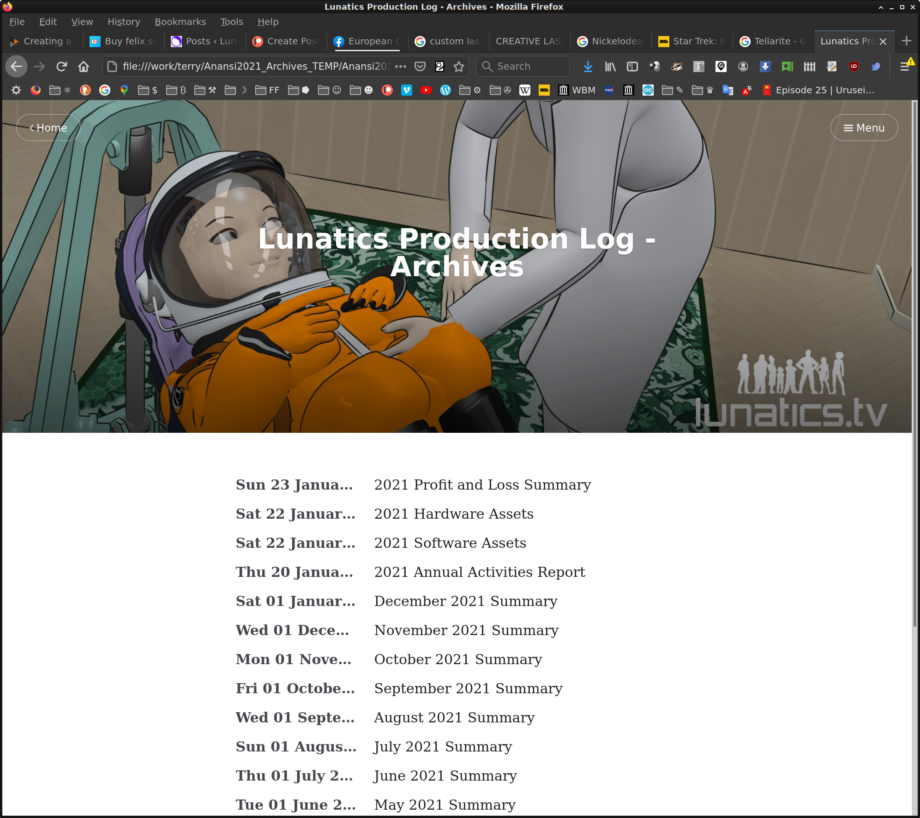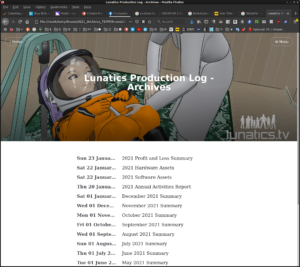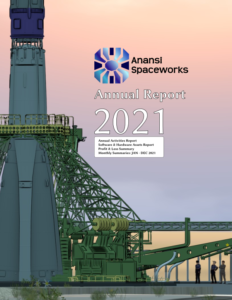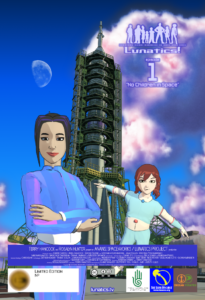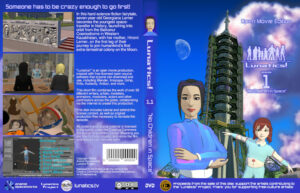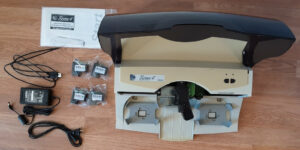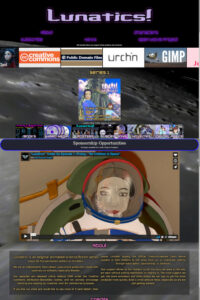HIGHLIGHTS:
Most of this month was taken up by administrative tasks, but I got them done earlier than in past years: the worklog summaries, the annual report, accounting, and filling out the 1065 partnership return (though I still need to double check it and then submit it).
I also did a lot of looking forward and planning out what I’d like to try to get accomplished in 2022, setting the following main goals:
- Upgrade the release and project websites for “Lunatics!”
- Rebuild Primera Bravo II disk duplicator with M-Disc capacity
- Write “Bunsen” disk duplicator automation software
- Complete/test Lib-Ray player and release on GitHub
- Finish and release Episode 1 of “Lunatics!”
- Finish the “Down the Rabbit Hole” greenscreen tutorial (with update)
- Create a certified “Limited Edition” cover art print for the Ep 1 release
- Release a project history and technical book, “Film Making for Lunatics!”
- Release an updated “Lunatics! Writer’s Guide”
- Finish bathroom remodeling
- Level and align the shop and library buildings
- Improve marketing and make sales
PRODUCTION:
Large Subversion check-in with all the work from 2021 that I hadn’t already committed.
MARKETING:
Developed an idea to create a certified “Limited Edition” cover art print series as a main way to make money from the episode release. This is sort of an old-school approach to the NFT craze, that I like a lot better, and it gets away from the commodity-thinking around DVD releases, by being an explicitly status-based sale.
IT:
Reconfigured Seafile to handle larger files, mostly so I can upload live video from my smartphone for logs.
CONSTRUCTION / MAINTENANCE:
Worked on creating bracing for the front door frame, so I can properly repair it.
Troubleshooting work on Nissan Altima and red Toyota Prius, but they are still not ready to return to service, so I’m having to do a lot of driving to get Rosalyn and Sylvan both to work.
BUSINESS:
Collected expense information. We had no revenue at all this year.
Created my ODS “Profit & Loss” spreadsheet. Wrote Annual Activies, Software Assets, Hardware Assets, and Profit & Loss Summary reports.
Exported and converted monthly summaries from the Production Log, and used Pelican to create an offline HTML static website of them to write to a M-Disc Blu-Ray archive.
Created a PDF version of the reports, which came to be a 160-page book, so I sent it to Lulu.com for printing.
PERSONAL:
Created a long, short, and really short video presentation for our Summer 2021 trip to New Mexico. The short video was included in my monthly summary for August. The long one might be converted further into a series of shorter videos, since it’s over 3 hrs, as-is.
Tried out Paramount+ streaming, and got caught up on Star Trek series. Interesting experience, but I’m still not a big fan of the commercial streaming business model.
January 2021 Summary
I spent the month of January on administrative tasks: accounting, an annual report, and filling out my partnership return. In short: no revenue, but the usual operating expenses (which is mostly to keep the website and studio computers running).
In the process, I learned how to use some new software:
I used the built-in Export feature for WordPress, Pelican , the “pelican-import” script that comes with it, and Pandoc to migrate articles from the Lunatics Project Production Log to RST, HTML, and PDF files for offline archiving.
Then I drafted my annual reports (Profit & Loss Statement, Hardware Assets, Software Assets, Activities Report) directly in RST and included those. I also finished the final edits and packed up all the daily worklog screencasts, monthly summaries, video and PR image releases, and the project source code files and saved them on a set of M-Disc Blu-Ray media for offline archival storage.
I converted the whole report into PDF, which serves as my official “Annual Report”. To my surprise, this came to over 150 pages, with the four annual report articles and the 12 monthly summaries (adapted from the online Production Log). Rather than send this behemoth to my office printer, I decided to design a cover for it and send it to Lulu to print as a book! I don’t anticipate any market for the print book other than myself, but you can get the PDF here:
Anansi Spaceworks Annual Report 2021 (PDF 37MB)
This might seem like overkill for a report, but it was actually a very streamlined way to make a readable, if utilitarian, book. I did the whole book design in one day. And if you take out the learning curve, converting, illustrating, reformatting, and copy-editing the articles took no more than a week or two. That’s pretty good! The last time I made a book of this size, it took months of layout in Scribus and Open Office.
As well as it is working, I may start working backwards to document previous years this way — I have the summaries back to 2018, and then articles on the Production Log back to 2011, many of them migrated from prior sources, as well as some (less detailed) reports I wrote at the time. Would be a pretty good way to create an archive of the project’s history.
I’m thinking this might be a good workflow for future documentation, like a new edition of the Writer’s Guide. The old Writer’s Guide & Artbook is fairly out of date, now, and I decided that it would probably be better to separate it into two books. The Writer’s Guide can be printed pretty cheaply in B&W, while I’d reserve the high-quality printing for the Artbook. Another candidate for this streamlined approach would be the “Film Making for Lunatics!” guide to free film production (with a bit of a project history).
Cover Art Poster
I have what should be the final, retouched version of the cover art poster for Episode 1, ready for use in publications. At the resolution I can include it here, it looks the same, but it does look better up close. My daughter, Ariel Hancock, whom you’ve heard as the voice of Georgiana (and also Saffron in “Pepper & Carrot” ep 6) is also a digital artist. She uses Krita a lot more than I do, and so she was kind enough to handle the retouching for me.
I am considering options for what all to do with this art. Obviously, the original purpose is to create a video “poster” for use online and “cover art” for DVD or accompanying books, and a physical poster for advertising at events.
Non-Fungibility, Collectibles, and Limited Edition Prints
There’s a lot of chatter about Non-Fungible Tokens these days, both from the crypto enthusiasts who are excited about them and from critics who have pretty much decided they truly hate them, citing various reasons from “environmental” (the argument is that energy used on the “proof” calculations used to “mint” an NFT, and that these are inherently designed to waste cycles and therefore waste energy and generate pollution) to “driving up the price of graphics cards (which can also be used to compute hashes for crypto-mining). I am aware that there are counter-arguments. Other critics argue that they are essentially financial or “money laundering” scams (more a criticism of how they are being used, rather than of the technology itself).
However, NFTs have also just kind of left me cold. They are essentially a pure, digital, cryptographic means of “proving scarcity”. And you don’t get anything tangible with an NFT. Nothing to hang on your wall. This does not bring me joy. So, I’ve decided they are probably not for me.
However, the “collectible” market is still a nice idea, and there are older ways of certifying “authenticity”, relying on tangible certificates or collectible items. This seems like a more promising option, to me.
Originally, I had planned for the DVD release to serve this role, but DVDs are generally perceived as commodities, and thus expected to be pretty cheap. They are also not nearly as popular today, with the growth of streaming services. We will certainly sell these, but I’m not convinced the market would support the income it takes to offset the cost of an episode.
So, my thought is to create a limited-edition art print run, and offer those for sales as a principal means of sales income associated with the episode release. Of course, an immediate consideration is how to produce the prints so that they are difficult to counterfeit (Not that that’s terribly likely, but it could happen, and besides, it’s kind of a fun project).
Work-in-Progress on designing the Limited-Edition Print. I’m thinking about removing the text at the top for this edition, to show the art better — but then possibly re-add it by etching it onto a glass cover for the high-end #1-#10 prints. The “authenticity” features will be in the signing block at the bottom, but I expect to make changes to the layout.
Well, I did a little research this month into techniques used for to certify “authenticity”: for credit cards, currency bills, deeds, and collectible items (because I’m not the first person to think of this, of course).
I came up with a list of technologies that wouldn’t be prohibitively expensive to use on a reasonable print run and could be made attractive as enhancements to the basic “giclee” digital prints:
- Anti-tamper hologram labels with sequential stamp
- Embossed seal with or without foil
- Hand-stamping with logo stamp and/or numerical sequence
- Specialty inks for the stamps: metallic, fluorescent, or even UV-active “invisible ink”
- And of course, hand-written signatures or personalizations
- 3D-Printed frame customizations or etched glass cover
There are some other techniques that I rejected as too difficult or expensive, at least for 13×19 prints:
- Microprinting (could only do stickers, and the holograms look cooler).
- Custom Watermarking. Available for 8.5×11 paper, but not poster-sizes.
- Embedded custom paper (color rag content, security strips, etc). You need a really large project for this to be practical (they use them for printed currency — some of these papers are probably actually illegal to buy, for anti-counterfeiting reasons!).
The notion would then be to do a single limited printing of 300 of these prints, with prices stepped by the print numbers:
- #141-300: 160 basic LE prints, to sell at $30 each.
- #100-140: 41 reserved as gifts to in-kind contributors, including artists, actors, etc.
- #11-99: 89 Sold at $300 each
- #10: 1, sold at $1500
- #2-9: 8 sold at $3000 each, and…
- #1: $30,000 (basically “a full-episode sponsorship with LE print #1 as the certificate”).
The low-numbered prints, and particularly print #1, might have some further enhancements, possibly with the custom frame with 3D printing or etched glass over the print itself. They might also be on slightly heavier or more durable paper (though all of the prints would be on acid-free archival art printing paper — we have a supplier for these kinds of high-quality prints already). But for the most part, the value is in the uniqueness.
It’s very likely that I will have to keep that #1 print for years, but I’ll reserve it as an investment in case the market comes around. Probably display it in the studio until that day.
None of this is a final decision, yet. Just a plan I’ve been working out. However, if ALL of the limited edition prints sold, they’d raise about $100,000 for the episode, which is the earning target I would be shooting for for artists to get something close to “union minimums” for the work they put in (I did some calculations back when I set up the original Kickstarter campaigns, and this is close to the number I came up with).
Advertising Posters
To be clear, the 13×19 “prints” are not the same as the 12×18 “posters”, although they will both feature the cover art design. They will be to the same scale — the art prints will have a bit of extra around them to allow for framing or matting, while the advertising posters are meant to be posted as they are, so they don’t need the extra margin.
I will be designing an “advertising poster” for unlimited printing. This will have more text on it, including sponsor names, and space to note a venue (for festival showings or whatever). It’ll probably be printed by our usual flyer printer, that we used for previous poster runs, and on a standard poster paper. This will be sold for something closer to the printing and handling costs. I don’t know the amount yet, but I’ll probably be shooting for $10 or so. So, if you have a limited budget and just want a picture to hang, these will be available. And of course, I’ll have some to give away at any in-person events we attend (I sincerely hope that will be feasible in the not-too-distant future!).
Open Movie Edition DVDs
I will also be offering an Open Movie DVD. This will contain the episode in NTSC format, playable on (most?) DVD players. Technically, since I am doing all of this with free software (DVD Styler, in particular, for DVD authoring), the disks are being made to the reverse-engineered DVD standard, without access to the official DVD spec, authoring software, or trademark logo. In practice, however, I have never found a player that wouldn’t play disks made with DVD Styler, and it is possible to author quite complex DVD menus with it.
The disks will be all-region, and I intend to offer the same disk, regardless of region, to minimize production costs.
As currently planned, the disk will be a single-layer, DVD-5, disk (meaning about 4.5 GB of space). This should be enough for the episode in standard-definition VOB format, the episode in high-definition H264 or VP9 encoding as data on the disk, and a portion of the source files, hopefully including the ones used in making this episode.
However, it is possible that it is not all going to fit on that one disk, and I may reserve some source to go on disks 2 and 3 in the series (there’s a certain amount of “front-loading” of production files, so I think this may make sense as a way to spread the data out).
If, for some reason, I can’t get everything to work out with episodes and source data, I’ll offer a “Supplemental Data” disk with the rest of the sources, and there may be additional “Tutorial” disks, with the collected tutorials and documentation I’ve created (for Episode 1, I was hoping to include the “Two Minute Tutorials” series as extras).
I may have already posted this, but, last year, I created a promotional video for this DVD edition (I might redraft this with more up-to-date details when I’m closer to release):
https://vimeo.com/517555310/ad564e3505
It has been suggested that I do a PAL conversion for the video. This would be at a higher resolution, but also a lower framerate than NTSC. These days, I’m pretty sure that most DVD or Blu-Ray players anywhere in the world can play both NTSC and PAL disks, so I’m not sure there’s a compatibility issue either way. But if I need to do a second disk, I could try this out. However, the DVD standard does not allow for a single disk to support both.
Blu-Ray/Lib-Ray/M-Disc Editions
I started the “Lib-Ray” Project with the intent to provide an open-source alternative to releasing on Blu-Ray, by simply combining existing video encoding technology, HTML-like menu design, available data-storage media, and video-quality standards, based on a measurement suite to be set up based on existing video comparison software.
My plan was to use this format to release “Lunatics!” episodes, and I would still like to do that.
However, my development work on a reference Lib-Ray player has been stalled for years, even though I have made progress by fits and starts over that time, and I did start setting it up with tests in my Eclipse workspace in 2020 and 2021. I’m planning to put more effort into that this year, but I feel very hesitant to make promises about it. The current obstacle to overcome is to rebuild the LibRocket C/C++ library and the RocketStandalone C-Python extension modules in my Eclipse environment — and then hopefully fix the bug that was causing RocketStandalone to crash.
After that, there is still a lot of work to do to test the video playback and menu navigation modules, as well as integrating it all into a usable player. It’s a lot of work to do, and there are many opportunities for me to stumble in the process.
It’s still officially in my goals for this year to get this released and working, and then to master a Lib-Ray edition of the “Lunatics!” Open Movie Edition pilot.
I now plan to implement Lib-Ray on M-Disc Blu-Ray media as a semi-standard format, although I still plan to leave the hardware layer flexible.
When I launched the Kickstarter in 2012, good physical media adequate for storing a Lib-Ray volume were a quandary: the Blu-Ray data disk media would work, but a durable Blu-Ray would have meant a pressed-one, like commercial Blu-Ray movie disks. And that would require purchasing licenses from the people developing Blu-Ray DRM, which sort of contradicted the purpose of creating an alternate format. Dyed-based BDRs would work in the short term, but they weren’t a good long-term solution. I settled on using SD Cards instead, because they had a number of good features, but they aren’t necessarily a good archival format and neither are they completely free — the “Secure” in “Secured Digital” means that they implement hardware-level DRM.
I had lamented at the time that M-Disc media were only available up to the 4.5 GB single-layer DVD size, because they seemed otherwise to be a good option for short-runs of durable media for video.
And fortunately, since then, M-Disc BDRs have been made available! There are 25 GB and 50 GB M-Disc media available, now licensed to industry disc manufacturers. I’m currently using the Verbatim-branded M-Disc BDRs for my project archives, for example.
Various optical media, including M-Disc BDRs that I use for archival data storage.
So I decided to just go ahead and switch to this medium. Duplication of M-Discs is not as widely available, so I looked for ways to do it here on site, and that’s what ultimately led me to the idea of converting an existing DVD disk-duplicator/printer to do the job and to be automated from Linux.
The “Primera Bravo II” was the only one I could find that had ever supported Linux directly, although the support wasn’t 100% (in fact, it only supported the printer function, and in a very limited way). I was able to find reverse-engineered documentation, and I was able to purchase a used one (with a non-working disk burner) pretty inexpensively on eBay.
Primera Bravo II that I purchased on eBay in 2021.
The plan is to replace the DVD burner with an M-Disc BDR burner, and then to code the control software based on the reverse-engineered command language for the robotics. The printer is based on a known ink-jet printer, so there’s a good chance I can find a driver that will work with it — and Primera did provide one. I’m not sure how the disk drive was interfaced, but it looks like a standard internal drive. If it won’t work as originally interfaced, I also have the option of just running a separate external interface to connect a standard SATA drive.
Either way, I should be able to create a disk-duplicating robot for burning and printing M-Disc Blu-Ray/Lib-Ray disks.
I know that’s a lot of “IFs”, but finishing this is one of my goals for 2022.
Website/Virtual-Studio Upgrades
I am planning to further split the “project” website from the “release” website, and make improvements to both.
For the release website, I’ve made extensive improvements to the LunaGen static website generator, separating the program code from the specific design for the “Lunatics!” site. I got very close to finishing this in December, when I stopped for Christmas break, and I hope to finish that work in February.
The main impact of this on the “Lunatics!” site is that I plan to update it more frequently, and the site will be set to regenerate the random elements like banners (they’ve been stuck on the same small collection for over a years now).
Lunatics Project / Virtual Studio Site
In the interest of self-hosting future collaboration, I need to set up a lot of software applications on the server. I have been struggling to keep up with the IT requirements for this, and in 2021, I started figured out how I might get out of that dilemma between wanting particular specialized open-source software and not wanting to spend so much time installing and testing it.
After joining a Mastodon instance (mastodon.art) last year, I discovered some alternatives, including YunoHost, that I’m hoping will be an easier way to deploy at least some of the tools I want to use, replacing my custom configurations with more-standardized ones, or new tools that provide features I hadn’t thought of yet.
I still don’t know if it’ll work, but my February goals include trying it out experimentally. I won’t be able to decide on exactly what collaboration and publishing tools I will be incorporating, but browsing the YunoHost “apps” list does turn up some promising candidates, such as:
- Mastodon
- PeerTube
- Castopod (Podcasting host)
- FunkWhale (SoundCloud-like audio-posting site)
- WordPress (I.e. migrate posts from my existing instance)
- Mumble (VOIP/chat)
- Various wiki packages, including, but not limited to MediaWiki
- Whitebophir (digital whiteboard)
- OwnCloud (cloud storage and synchronization)
- OwnCast (live video streaming)
- OnlyOffice (Online office suite)
- Seafile (file sync I use on my home LAN, but not yet on the remote server)
- Gitea (GitHub/GitLab alternative)
My immediate plan is to set up a test server, install all of these and any other apps that seem interesting, and then test them out for awhile. Later, I’ll choose which ones I want to incorporate into my “Virtual Studio” workflow, and do that installation from a fresh start.
Not ALL of the web applications I would like to have are represented. As far as I can tell, there are currently no YunoHost apps for:
- Subversion
- Trac
- Resource Space
- TACTIC
- Prism-Pipeline
- Big Blue Button
After the YunoHost experiment, I’ll have to decide if these apps should be replaced by an already-available app, installed manually as I have been doing up until now, or if it’s easy enough to create new YunoHost apps for them.
I’m not sure how this fits in with Ansible — whether YunoHost would replace it, or work alongside it, or be controlled by it. These are all things I hope to find out through the test.
YunoHost is already based on Debian, which is what I’ve been using on the server all along, so that’s a help.
Software Development and Packaging
I plan to finish LunaGen up to the point where I can put it up on GitHub.
I need to install Papagayo NG, which is considerably upgraded from before, and then see if I can reincorporate my patches for it, and hopefully get them included upstream. The most significant being Japanese language support.
I need to setup a C/C++ development environment in Eclipse and get LibRocket and RocketStandalone to compile in it, as well as setup unit tests for them, for Lib-Ray Player development.
And then I need to get compositing file support into ABX, as well as port the add-on to Blender 2.83 (and possibly 3.x).
Production – Animation
Finally, I’m hoping to get back onto modeling, rigging, and animation work that I stopped on in the Fall: re-rigging the ragdoll “space bunny” for Georgiana, upgrading the life-support pack, and updating the shots in the “Suiting Up” sequence. Then, I have character animation to do in “Suiting Up”, “Launch”, and “Soyuz Flight” sequences.
I need to use the Papagayo NG package to update the lipsync in some scenes and start new lipsync in the others.
Once that’s done, I still have repair and reconstruction work to do on the “Train” scene at the beginning of the episode.
And then I’ll be into rendering and sound production, and after that, compositing, and final editing/mixing for release.
I doubt all of this will get done in February, so this is probably the plan for the next few months. But we’ll see how far I get!
Thank you so much, all of you, for your support of our Patreon. I should have more to post about in February, and more to show. Although I sacrificed most of January on paperwork and musings, this does mean I don’t have the paperwork hanging over me anymore — which puts me ahead of where I’ve been at the beginning of February in the previous few years. So I’m actually feeling pretty good about where I’m at.
Talk to you again soon!
